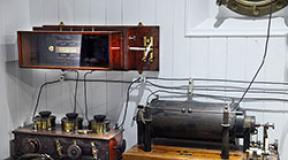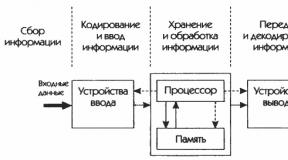Production of modern processors. Technological excursion. What is silicon, and why are computer chips made from it? What does a processor chip consist of?
The roots of our digital lifestyle definitely come from semiconductors, which have enabled the creation of complex transistor-based computing chips. They store and process data, which is the basis of modern microprocessors. Semiconductors, which are made from sand today, are a key component in almost every electronic device, from computers to laptops to cell phones. Even cars now cannot do without semiconductors and electronics, since semiconductors control the air conditioning system, the fuel injection process, the ignition, the sunroof, the mirrors and even the steering (BMW Active Steering). Today, almost any device that consumes energy is built on semiconductors.
Microprocessors are without a doubt among the most complex semiconductor products, with the number of transistors soon to reach one billion and the range of functionality already astonishing today. Dual-core Core 2 processors will soon be released on Intel's almost finished 45 nm process technology, and they will already contain 410 million transistors (although most of them will be used for the 6 MB L2 cache). The 45nm process is named for the size of a single transistor, which is now about 1,000 times smaller than the diameter of a human hair. To a certain extent, this is why electronics begins to control everything in our lives: even when the transistor sizes were larger, it was very cheap to produce not very complex microcircuits, the budget for transistors was very large.
In our article we will look at the basics of microprocessor manufacturing, but we will also touch on the history of processors, architecture and look at the different products on the market. You can find a lot of interesting information on the Internet, some of which are listed below.
- Wikipedia: Microprocessor. This article covers different types of processors and provides links to manufacturers and additional Wiki pages dedicated to processors.
- Wikipedia: Microprocessors (Category). The section on microprocessors provides even more links and information.
PC Competitors: AMD and Intel
The headquarters of Advanced Micro Devices Inc., founded in 1969, is located in Sunnyvale, California, and the “heart” of Intel, which was founded just a year earlier, is located a few kilometers away in the city of Santa Clara. AMD today has two factories: in Austin (Texas, USA) and in Dresden (Germany). The new plant will come into operation soon. In addition, AMD has joined forces with IBM in processor technology development and manufacturing. Of course, this is all a fraction of Intel's size, as the market leader now operates nearly 20 factories in nine locations. About half of them are used to produce microprocessors. So when you compare AMD and Intel, remember that you are comparing David and Goliath.
Intel has an undeniable advantage in the form of huge production capacity. Yes, the company today is a leader in the implementation of advanced technological processes. Intel is about a year ahead of AMD in this regard. As a result, Intel can use more transistors and more cache in its processors. AMD, unlike Intel, has to optimize its technical process as efficiently as possible in order to keep up with its competitors and produce decent processors. Of course, the design of processors and their architecture are very different, but the technical manufacturing process is built on the same basic principles. Although, of course, there are many differences in it.
Microprocessor manufacturing
The production of microprocessors consists of two important stages. The first is the production of the substrate, which AMD and Intel carry out in their factories. This includes imparting conductive properties to the substrate. The second stage is substrate testing, assembly and packaging of the processor. The latter operation is usually performed in less expensive countries. If you look at Intel processors, you will find an inscription that the packaging was carried out in Costa Rica, Malaysia, the Philippines, etc.
AMD and Intel today are trying to release products for the maximum number of market segments, and, moreover, based on the minimum possible range of crystals. A great example is the Intel Core 2 Duo processor line. There are three processors with code names for different markets: Merom for mobile applications, Conroe for desktop version, Woodcrest for server version. All three processors are built on the same technological basis, which allows the manufacturer to make decisions at the final stages of production. You can enable or disable features, and the current level of clock speeds gives Intel an excellent percentage of usable crystals. If there is increased market demand for mobile processors, Intel may focus on releasing Socket 479 models. If demand for desktop models increases, the company will test, validate and package dies for Socket 775, while server processors are packaged for Socket 771. So Even quad-core processors are being created: two dual-core chips are installed in one package, so we get four cores.
How chips are created
Chip production involves depositing thin layers with complex “patterns” onto silicon substrates. First, an insulating layer is created that acts as an electrical gate. Photoresist material is then applied on top, and unwanted areas are removed using masks and high-intensity irradiation. When the irradiated areas are removed, areas of silicon dioxide underneath will be exposed, which is removed by etching. After this, the photoresist material is also removed, and we obtain a certain structure on the silicon surface. Additional photolithography processes are then carried out, with different materials, until the desired three-dimensional structure is obtained. Each layer can be doped with a specific substance or ions, changing the electrical properties. Windows are created in each layer so that metal connections can then be made.
As for the production of substrates, they must be cut from a single cylinder monocrystal into thin “pancakes” so that they can then be easily cut into individual processor chips. At every step of production, complex testing is performed to assess quality. Electrical probes are used to test each chip on the substrate. Finally, the substrate is cut into individual cores, and non-working cores are immediately eliminated. Depending on the characteristics, the core becomes one or another processor and is packaged in a package that makes it easier to install the processor on the motherboard. All functional units undergo intensive stress tests.
It all starts with the substrates
The first step in manufacturing processors is done in a clean room. By the way, it is important to note that such high-tech production represents an accumulation of enormous capital per square meter. The construction of a modern plant with all the equipment easily costs 2-3 billion dollars, and test runs of new technologies require several months. Only then can the plant mass produce processors.
In general, the chip manufacturing process consists of several wafer processing steps. This includes the creation of the substrates themselves, which will eventually be cut into individual crystals.

It all starts with growing a single crystal, for which a seed crystal is embedded in a bath of molten silicon, which is located just above the melting point of polycrystalline silicon. It is important that the crystals grow slowly (about a day) to ensure that the atoms are arranged correctly. Polycrystalline or amorphous silicon consists of many different crystals, which will lead to the appearance of undesirable surface structures with poor electrical properties. Once the silicon is molten, it can be doped with other substances that change its electrical properties. The entire process takes place in a sealed room with a special air composition so that the silicon does not oxidize.
The single crystal is cut into “pancakes” using a diamond hole saw, which is very accurate and does not create large irregularities on the surface of the substrate. Of course, the surface of the substrates is still not perfectly flat, so additional operations are required.
First, using rotating steel plates and an abrasive material (such as aluminum oxide), a thick layer is removed from the substrates (a process called lapping). As a result, irregularities ranging in size from 0.05 mm to approximately 0.002 mm (2,000 nm) are eliminated. Then you should round the edges of each backing, as sharp edges can cause layers to peel off. Next, an etching process is used, when using various chemicals (hydrofluoric acid, acetic acid, nitric acid) the surface is smoothed by about 50 microns. The surface is not physically degraded since the entire process is completely chemical. It allows you to remove remaining errors in the crystal structure, resulting in a surface that is close to ideal.
The last step is polishing, which smoothes the surface to a maximum roughness of 3 nm. Polishing is carried out using a mixture of sodium hydroxide and granular silica.
Today, microprocessor wafers are 200mm or 300mm in diameter, allowing chip makers to produce multiple processors from each one. The next step will be 450mm substrates, but we shouldn't expect them before 2013. In general, the larger the diameter of the substrate, the more chips of the same size can be produced. A 300mm wafer, for example, produces more than twice as many processors as a 200mm wafer.

We have already mentioned doping, which is performed during the growth of a single crystal. But doping is done both with the finished substrate and later during photolithography processes. This allows you to change the electrical properties of certain areas and layers, and not the entire crystal structure
The addition of the dopant can occur through diffusion. Atoms of the dopant fill the free space inside the crystal lattice, between the silicon structures. In some cases, it is possible to alloy the existing structure. Diffusion is carried out using gases (nitrogen and argon) or using solids or other sources of alloying substance.
Another approach to doping is ion implantation, which is very useful in changing the properties of the substrate that has been doped, since ion implantation is carried out at normal temperatures. Therefore, existing impurities do not diffuse. You can apply a mask to the substrate, which allows you to process only certain areas. Of course, we can talk about ion implantation for a long time and discuss the depth of penetration, activation of the additive at high temperatures, channel effects, penetration into oxide levels, etc., but this is beyond the scope of our article. The procedure can be repeated several times during production.
To create sections of an integrated circuit, a photolithography process is used. Since it is not necessary to irradiate the entire surface of the substrate, it is important to use so-called masks that transmit high-intensity radiation only to certain areas. Masks can be compared to black and white negatives. Integrated circuits have many layers (20 or more), and each of them requires its own mask.
A structure of thin chrome film is applied to the surface of a quartz glass plate to create a pattern. In this case, expensive instruments using an electron beam or a laser write the necessary integrated circuit data, resulting in a chromium pattern on the surface of a quartz substrate. It is important to understand that each modification of an integrated circuit leads to the need to produce new masks, so the entire process of making changes is very expensive. For very complex schemes, masks take a very long time to create.


Using photolithography, a structure is formed on a silicon substrate. The process is repeated several times until many layers (more than 20) are created. The layers can consist of different materials, and you also need to think through connections with microscopic wires. All layers can be alloyed.
Before the photolithography process begins, the substrate is cleaned and heated to remove sticky particles and water. The substrate is then coated with silicon dioxide using a special device. Next, a coupling agent is applied to the substrate, which ensures that the photoresist material that will be applied in the next step remains on the substrate. Photoresist material is applied to the middle of the substrate, which then begins to rotate at high speed so that the layer is evenly distributed over the entire surface of the substrate. The substrate is then heated again.
Then, through the mask, the cover is irradiated with a quantum laser, hard ultraviolet radiation, x-rays, beams of electrons or ions - all of these light or energy sources can be used. Electron beams are used mainly to create masks, X-rays and ion beams are used for research purposes, and industrial production today is dominated by hard UV radiation and gas lasers.

Hard UV radiation with a wavelength of 13.5 nm irradiates the photoresist material as it passes through the mask.
Projection time and focus are very important to achieve the desired result. Poor focusing will result in excess particles of photoresist material remaining because some of the holes in the mask will not be irradiated properly. The same thing will happen if the projection time is too short. Then the structure of photoresist material will be too wide, the areas under the holes will be underexposed. On the other hand, excessive projection time creates too large areas under the holes and too narrow a structure of photoresist material. As a rule, it is very labor-intensive and difficult to adjust and optimize the process. Unsuccessful adjustment will lead to serious deviations in the connecting conductors.
A special step-by-step projection installation moves the substrate to the desired position. Then a line or one section can be projected, most often corresponding to one processor chip. Additional micro-installations may introduce additional changes. They can debug existing technology and optimize the technical process. Micro installations usually work on areas smaller than 1 square meter. mm, while conventional installations cover larger areas.

The substrate then moves to a new stage where the weakened photoresist material is removed, allowing access to the silicon dioxide. There are wet and dry etching processes that treat areas of silicon dioxide. Wet processes use chemical compounds, while dry processes use gas. A separate process involves removing remnants of photoresist material. Manufacturers often combine wet and dry removal to ensure that the photoresist material is completely removed. This is important because photoresist material is organic and if not removed can cause defects on the substrate. After etching and cleaning, you can begin to inspect the substrate, which usually happens at each important stage, or transfer the substrate to a new photolithography cycle.
Substrate testing, assembly, packaging

Finished substrates are tested in so-called probe testing installations. They work with the entire substrate. Probe contacts are applied to the contacts of each crystal, allowing electrical tests to be carried out. The software tests all functions of each core.

By cutting, individual kernels can be obtained from the substrate. At the moment, probe control installations have already identified which crystals contain errors, so after cutting they can be separated from the good ones. Previously, damaged crystals were physically marked, but now there is no need for this, all information is stored in a single database.
Crystal mount
The functional core must then be bonded to the processor package using adhesive material.

Then you need to make wire connections connecting the contacts or legs of the package and the crystal itself. Gold, aluminum or copper connections can be used.

Most modern processors use plastic packaging with a heat spreader.
Typically the core is encased in ceramic or plastic to prevent damage. Modern processors are equipped with a so-called heat spreader, which provides additional protection for the chip, as well as a larger contact surface with the cooler.
CPU testing
The last stage involves testing the processor, which occurs at elevated temperatures, in accordance with the processor specifications. The processor is automatically installed in the test socket, after which all necessary functions are analyzed.
Big things start small. This statement is true for many things, but in this article we will talk about the manufacture of microprocessors, which are stuffed into a wide variety of household appliances that surround you, from smartphones to refrigerators.
Preparation of raw materials
Computer chips of the most complex structure, capable of performing instant calculations, are born in huge quartz glass crucibles filled to the brim with sand that has undergone multi-stage cleaning.First of all, “technical” silicon is obtained from sand collected in some quarry by adding carbon to the mineral at high temperature. The resulting silicon reaches 98% purity, but is still completely unsuitable for electronics applications and requires additional chlorine treatment to become “electronic silicon.” During a cascade of chemical reactions with chlorine, silicon is literally synthesized anew, getting rid of the last traces of impurities.
Only after this the crucible with the purest electronic silicon is placed in a sealed oven filled with argon. Of course, it would be possible to pump the air out of it, but creating a perfect vacuum on earth is very difficult, if not impossible, and from a chemical point of view, argon gives almost the same effect. This inert gas replaces oxygen, protecting the composition from oxidation, and does not react in any way with silicon in the crucible.
Only after this does the former sand heat up to 1420 degrees Celsius, which is only 6 degrees above its melting point. A graphite heater is used for this. The choice of material, as in the case of quartz crucible, is due to the fact that graphite does not react with silicon and, therefore, cannot contaminate the material of the future processor.
A thin silicon seed crystal, the size and shape of a pencil, is lowered into a heated crucible. It should start the crystallization process. The following can be reproduced at home with a solution of salt, sugar, citric acid or, for example, copper sulfate. The cooling solution begins to crystallize around the seed point, forming an ideal molecular lattice. This is how salt crystals are grown, and this is how silicon grows.

The silicon seed crystal is gradually lifted from the crucible, at a speed of about one and a half millimeters per minute, and with it the growing single crystal rises from the solution. Crystal growth is slow and takes an average of 26 hours per crucible, so production runs around the clock.
During this time, a “boule” is formed - a solid cylindrical crystal with a diameter of 300 millimeters, a length of up to 1-2 meters and a weight of about 100 kilograms. If you look at it under high magnification, you will see a strict structure - an ideal crystal lattice of silicon atoms, completely homogeneous throughout the entire volume.
The crystal is so strong that its weight can be supported by a thread with a diameter of only 3 millimeters. So, the finished workpiece for processors is pulled out of the crucible by the same seed crystal.
However, the “boule” is handled more carefully than an antique vase; the crystal can withstand enormous tensile loads, but is extremely fragile.
After chemical and X-ray examination to verify the purity of the crystal and the correctness of the molecular lattice, the workpiece is placed in a silicon cutting machine. She cuts the crystal into wafers about 1 millimeter thick using a diamond-coated wire saw.
Of course, it doesn't come without damage. No matter how sharp the saw is, after cutting, microscopic defects remain on the surface of the plates. So the slicing is followed by a polishing step.
But even after processing in a powerful grinding machine, the silicon wafers are still not smooth enough to be used for the production of microchips. Therefore, polishing is repeated again and again using chemical reagents.
![]()
The result is a surface in comparison with which the mirror resembles coarse sandpaper. Such a plate, without breaks or microdefects, becomes the basis for millions of microelectronic devices that form a microcircuit. Cleaned of dust, silicon disks, which are commonly called “wafers” or “wafers,” are sent to a clean room in sealed containers.
In a clean room

In 1958, the inventor of the integrated circuit, Jack Kirby, managed to make a breakthrough by placing a single transistor on his circuit. These days, the number of microprocessor logic elements has exceeded a billion and continues to double every two years in accordance with Moore's law.
Working with such microscopic parts poses a serious challenge for chip manufacturers, since even a single speck of dust can destroy a future product. Therefore, workshops with an area of a couple of thousand square meters are completely isolated from the outside world and equipped with sophisticated air purification and air conditioning systems, making it 10,000 times cleaner than in a surgical ward.
All specialists working in such a clean room not only maintain sterility, but also wear protective suits made of antistatic materials, masks, and gloves. And yet, despite all the precautions to reduce the risk of defects, processor manufacturing companies are trying to automate as much of the work done in the clean room as possible by outsourcing it to industrial robots.
![]()
The process of manufacturing processors has been put on the conveyor belt. Delivered in a sealed box, a perfectly smooth “wayfer” goes through 400-500 technological operations and leaves the workshop only a few months later in the form of a finished microchip.
Creating a microchip from a “wafer” involves building a very complex technological chain, which there is no way to describe in detail due to limitations on the volume of the article. Even if they didn’t exist, companies like Intel and AMD are in no hurry to share their production secrets. In the design departments of companies, complex three-dimensional diagrams of the relative arrangement of processor elements are designed - chip topologies. They represent a multi-level accumulation of elements, which is divided into layers and deposited layer-by-layer on a silicon substrate. Doing this manually, of course, is impossible, the process is too delicate, the elements are too small, literally nanometer in size.

Eighth-generation Intel processors, known as Coffee Lake, are studded with 14 nanometer transistors, AMD announced the second generation of AMD Ryzen processors, codenamed Pinnacle Ridge, built on 12 nanometer elements. The latest NVIDIA video cards with Volta core architecture are also built on 12 nm technology. The system on the Qualcomm Snapdragon 835 chip is even smaller - only 10 nanometers. It is possible to constantly reduce the size of the functional elements of the processor and, consequently, increase its performance thanks to the improvement of a technology called photolithography.
In general terms, this process can be described as follows:
First, the silicon wafer is coated with a base - the material that will be part of the future circuit, then a chemical reagent sensitive to light is applied on top in an even layer. This composition will do all the work, but the point will come later.
First, a closely guarded detailed processor design is extracted from corporate archives. Its bottom layer is presented in the form of a negative and transferred to a photomask - a protective plate that acts like a stencil. It is significantly larger than the chip, so the light passing through it is focused using a complex lens system, reducing the projected image to the desired size.
In those places where light does not reach the silicon, the wafer remains untouched; in illuminated areas, it initiates a reaction in the chemical reagent, changing its properties. Then the future processor will be treated with another composition, and these areas will dissolve, leaving only those areas that were not exposed. They form the conductive logic elements of the processor.

Afterwards, a layer of dielectric will be applied to the wafer and new processor components will be added on top, again using photolithography.
Some layers are heated, some are exposed to ionized plasmas, and others are coated with metal. Each type of processing changes the properties of the layer and slowly creates a piece of the puzzle that forms a specific chip model. The result is a kind of layer cake, where each layer has its own functionality and they are interconnected in a complex way through “tracks” of copper atoms, which are deposited on a silicon substrate from a copper sulfate solution, passing an electric current through it.

This is the final stage of processing, after which the microchips are checked for functionality. Despite all the precautions and many days of effort, the defect rate remains high. Robots will select and cut only 100% efficient chips from a silicon wafer.
They will be sorted by energy efficiency, current, and maximum operating frequencies, given different designations, and ultimately sold at different prices.
Finishing touches

On their way to customers, processors leave the clean room and are sent to an assembly line, where the finished chip is glued onto a square called a substrate. The crystal is soldered to it in a special oven at a temperature of 360 degrees Celsius.
The chip is then covered with a lid. It serves both to protect the still fragile silicon from damage and to remove heat from it. You probably imagine it well; the base of the cooling system, be it a cooler or a heat exchanger of a water cooling system, will be pressed against the cover. This is no less important stage than the previous one. After all, the stability and speed of its operation and its future maximum performance largely depend on how well the processor cover removes heat from the chip.
Old Intel processors were literally soldered to the heat distribution covers. However, the latest generations of proprietary chips receive a thermal interface gasket between the crystal and the cover and are cooled worse, which greatly upsets computer hardware enthusiasts who want to get the most out of their purchases. It’s gotten to the point where they “scalp” processors - they independently remove the heat spreader from them and replace the thermal interface with a more efficient one. But let's not get distracted by overclocking tricks, since the processor is not ready yet.

The final stage is the creation of electrical contacts that will connect the microprocessor to the computer motherboard. Typically, tin cylinders are made for this, the so-called “legs” of the processor, which are first glued and then soldered to the substrate, where places are pre-provided for them. For microchips with a large number of connections, small tin balls are sometimes used instead of legs, since they are stronger and more reliable, but recently they have begun to be abandoned in favor of simple contact pads.

The completed microchip is washed in a solution of water and a solvent to remove excess flux and dirt, and then a final quality check of the work done is carried out. These can range from performance stress tests, such as in a clean room, to more severe tests. Thus, chips intended to operate in extreme conditions, for example, in the space and military industries, are placed sealed in ceramic housings and repeatedly tested at extreme temperatures in vacuum chambers.
Then, depending on the purpose of the microprocessor, it is sent directly into the hands of customers, and then into the sockets of motherboards, or to other factories, where a small silicon crystal will take its place on the computer board of a video card, a space satellite, a smart refrigerator, or maybe end up in smartphone case.
The production of microcircuits is a very difficult matter, and the closedness of this market is dictated primarily by the features of the dominant photolithography technology today. Microscopic electronic circuits are projected onto a silicon wafer through photomasks, the cost of each of which can reach $200,000. Meanwhile, at least 50 such masks are required to make one chip. Add to this the cost of “trial and error” when developing new models, and you will understand that only very large companies can produce processors in very large quantities.
What should scientific laboratories and high-tech startups that need non-standard designs do? What should we do for the military, for whom purchasing processors from a “probable enemy” is, to put it mildly, not comme il faut?
We visited the Russian production site of the Dutch company Mapper, thanks to which the production of microcircuits can cease to be the lot of celestials and turn into an activity for mere mortals. Well, or almost simple. Here, on the territory of the Moscow Technopolis, with the financial support of the Rusnano Corporation, a key component of the Mapper technology is produced - the electron-optical system.
However, before understanding the nuances of Mapper maskless lithography, it is worth remembering the basics of conventional photolithography.
Clumsy Light
A modern Intel Core i7 processor can contain about 2 billion transistors (depending on the model), each of which is 14 nm in size. In pursuit of computing power, manufacturers annually reduce the size of transistors and increase their number. The likely technological limit in this race can be considered 5 nm: at such distances quantum effects begin to appear, due to which electrons in neighboring cells can behave unpredictably.
To deposit microscopic semiconductor structures on a silicon wafer, they use a process similar to using a photographic enlarger. Unless his goal is the opposite - to make the image as small as possible. The plate (or protective film) is covered with photoresist - a polymer photosensitive material that changes its properties when irradiated with light. The required chip pattern is exposed to a photoresist through a mask and a collecting lens. The printed wafers are typically four times smaller than the masks.
 Substances such as silicon or germanium have four electrons in their outer energy level. They form beautiful crystals that look like metal. But, unlike metal, they do not conduct electricity: all their electrons are involved in powerful covalent bonds and cannot move. However, everything changes if you add to them a little donor impurity from a substance with five electrons in the outer level (phosphorus or arsenic). Four electrons bond with the silicon, leaving one free. Silicon with a donor impurity (n-type) is a good conductor. If you add an acceptor impurity from a substance with three electrons at the outer level (boron, indium) to silicon, “holes” are formed in a similar way, a virtual analogue of a positive charge. In this case, we are talking about a p-type semiconductor. By connecting p- and n-type conductors, we get a diode - a semiconductor device that passes current in only one direction. The p-n-p or n-p-n combination gives us a transistor - current flows through it only if a certain voltage is applied to the central conductor.
Substances such as silicon or germanium have four electrons in their outer energy level. They form beautiful crystals that look like metal. But, unlike metal, they do not conduct electricity: all their electrons are involved in powerful covalent bonds and cannot move. However, everything changes if you add to them a little donor impurity from a substance with five electrons in the outer level (phosphorus or arsenic). Four electrons bond with the silicon, leaving one free. Silicon with a donor impurity (n-type) is a good conductor. If you add an acceptor impurity from a substance with three electrons at the outer level (boron, indium) to silicon, “holes” are formed in a similar way, a virtual analogue of a positive charge. In this case, we are talking about a p-type semiconductor. By connecting p- and n-type conductors, we get a diode - a semiconductor device that passes current in only one direction. The p-n-p or n-p-n combination gives us a transistor - current flows through it only if a certain voltage is applied to the central conductor.
The diffraction of light makes its own adjustments to this process: the beam, passing through the holes of the mask, is slightly refracted, and instead of one point, a series of concentric circles are exposed, as if from a stone thrown into a pool. Fortunately, diffraction is inversely related to wavelength, which is what engineers take advantage of by using ultraviolet light with a wavelength of 195 nm. Why not even less? It’s just that the shorter wave will not be refracted by the collecting lens, the rays will pass through without focusing. It is also impossible to increase the collecting ability of the lens - spherical aberration will not allow it: each ray will pass through the optical axis at its own point, disrupting focusing.
The maximum contour width that can be imaged using photolithography is 70 nm. Higher-resolution chips are printed in several steps: 70-nanometer contours are applied, the circuit is etched, and then the next part is exposed through a new mask.
Currently in development is deep ultraviolet photolithography technology, using light with an extreme wavelength of about 13.5 nm. The technology involves the use of vacuum and multilayer mirrors with reflection based on interlayer interference. The mask will also not be a translucent, but a reflective element. Mirrors are free from the phenomenon of refraction, so they can work with light of any wavelength. But for now this is just a concept that may be used in the future.
How processors are made today

A perfectly polished round silicon wafer with a diameter of 30 cm is coated with a thin layer of photoresist. Centrifugal force helps distribute the photoresist evenly.

The future circuit is exposed to a photoresist through a mask. This process is repeated many times because many chips are produced from one wafer.

The part of the photoresist that has been exposed to ultraviolet radiation becomes soluble and can be easily removed using chemicals.

Areas of the silicon wafer that are not protected by photoresist are chemically etched. In their place, depressions form.

A layer of photoresist is again applied to the wafer. This time, exposure exposes those areas that will be subject to ion bombardment.

Under the influence of an electric field, impurity ions accelerate to speeds of more than 300,000 km/h and penetrate the silicon, giving it the properties of a semiconductor.

After removing the remaining photoresist, finished transistors remain on the wafer. A layer of dielectric is applied on top, in which the holes for the contacts are etched using the same technology.

The plate is placed in a copper sulfate solution and a conductive layer is applied to it using electrolysis. Then the entire layer is removed by grinding, but the contacts in the holes remain.

The contacts are connected by a multi-story network of metal “wires.” The number of “floors” can reach 20, and the overall wiring diagram is called the processor architecture.

Only now the plate is cut into many individual chips. Each “crystal” is tested and only then installed on a board with contacts and covered with a silver radiator cap.
13,000 TVs
An alternative to photolithography is electrolithography, when exposure is made not by light, but by electrons, and not by photo-resist, but by electroresist. The electron beam is easily focused to a point of minimal size, down to 1 nm. The technology is similar to a cathode ray tube on a television: a focused stream of electrons is deflected by control coils, painting an image on a silicon wafer.
Until recently, this technology could not compete with the traditional method due to its low speed. In order for an electroresist to react to irradiation, it must accept a certain number of electrons per unit area, so one beam can expose at best 1 cm2/h. This is acceptable for single orders from laboratories, but is not applicable in industry.
Unfortunately, it is impossible to solve the problem by increasing the beam energy: like charges repel each other, so as the current increases, the electron beam becomes wider. But you can increase the number of rays by exposing several zones at the same time. And if several are 13,000, as in Mapper technology, then, according to calculations, it is possible to print ten full-fledged chips per hour.

Of course, combining 13,000 cathode ray tubes into one device would be impossible. In the case of Mapper, radiation from the source is directed to a collimator lens, which forms a wide parallel beam of electrons. In its path stands an aperture matrix, which turns it into 13,000 individual rays. The beams pass through the blanker matrix - a silicon wafer with 13,000 holes. A deflection electrode is located near each of them. If current is applied to it, the electrons “miss” their hole and one of the 13,000 beams is turned off.
After passing the blankers, the rays are directed to a matrix of deflectors, each of which can deflect its beam a couple of microns to the right or left relative to the movement of the plate (so the Mapper still resembles 13,000 picture tubes). Finally, each beam is further focused by its own microlens and then directed to an electroresist. To date, Mapper technology has been tested at the French microelectronics research institute CEA-Leti and at TSMC, which produces microprocessors for leading market players (including the Apple iPhone 6S). Key components of the system, including silicon electronic lenses, are manufactured at the Moscow plant.
Mapper technology promises new prospects not only for research laboratories and small-scale (including military) production, but also for large players. Currently, to test prototypes of new processors, it is necessary to make exactly the same photo masks as for mass production. The ability to prototype circuits relatively quickly promises to not only reduce development costs, but also accelerate progress in the field. Which ultimately benefits the mass consumer of electronics, that is, all of us.
CPU This is the heart of any modern computer. Any microprocessor is essentially a large integrated circuit on which transistors are located. By passing electric current, transistors allow you to create binary logic (on - off) calculations. Modern processors are based on 45 nm technology. 45nm (nanometer) is the size of one transistor located on the processor wafer. Until recently, 90 nm technology was mainly used.
The wafers are made from silicon, which is the second largest deposit in the earth's crust.
Silicon is obtained by chemical treatment, purifying it from impurities. After this, they begin to melt it, forming a silicon cylinder with a diameter of 300 millimeters. This cylinder is subsequently cut into plates with a diamond thread. The thickness of each plate is about 1 mm. To ensure that the plate has an ideal surface, after cutting with a thread, it is polished with a special grinding machine.
After this, the surface of the silicon wafer is perfectly smooth. By the way, many manufacturing companies have already announced the possibility of working with 450 mm plates. The larger the surface, the greater the number of transistors to accommodate, and the higher the processor performance.
CPU consists of a silicon wafer on the surface of which there are up to nine layers of transistors, separated by oxide layers for insulation.
Development of processor technology
Gordon Moore, one of the founders of Intel, one of the leaders in processor production in the world, in 1965, based on his observations, discovered a law according to which new models of processors and chips appeared at equal intervals of time. The number of transistors in processors is growing approximately 2 times in 2 years. For 40 years now, Gordon Moore's law has been working without distortion. The development of future technologies is just around the corner - there are already working prototypes based on 32 nm and 22 nm processor production technologies. Until mid-2004, processor power depended primarily on processor frequency, but since 2005, processor frequency has practically stopped growing. A new multi-core processor technology has appeared. That is, several processor cores are created with an equal clock frequency, and during operation the power of the cores is summed up. This increases the overall processor power.
Below you can watch a video about the production of processors.
This may seem like a stupid question that can be answered in one sentence: silicon is the 14th element on the periodic table. However, silicon is the most frequently mentioned on electronics websites because it is not only the main component of most building materials, but also the basis for modern computer processors, and even the most likely candidate for being the basis element of “carbon-free life.” What does silicon do? special?
Silicon as a building material
After oxygen, silicon is the most common element in the earth's crust, but it is not so easy to find, because it is almost never found in its pure form. The most commonly found in nature is silicate SiO4 or silicon dioxide SiO2. Silicon is also the main component of sand. Feldspar, granite, quartz - they are all based on a compound of silicon and oxygen.
![]()
Silicon compounds have a wide range of useful properties, mainly because they can bind other atoms very tightly together in complex structures. Various silicates, such as calcium silicate, are the main component of cement, the main binder of concrete and even plaster. Some silicate materials are used in ceramics, and, of course, glass. In addition, silicon is added to substances such as cast iron to make the alloy more durable.
And, yes, silicon is also the main structural component of the synthetic material silicone, which is why silicone is often confused with silicone. A famous example is Silicon Valley, which is actually silicon.
Silicon as a computer chip
When choosing a material for the base of computer transistors, resistance was a key factor. Conductors have low resistance and conduct current very easily, while insulators block current due to their high resistance. A transistor must combine both properties.
Silicon is not the only semiconductor substance on Earth - it is not even the best semiconductor. However, it is widely available. It is not difficult to obtain and is easy to work with. And most importantly, scientists have found a reliable way to produce ordered crystals from it. These crystals are to silicon what diamond is to diamond.
Building perfect crystals is one of the fundamental aspects of computer chip manufacturing. These chips are then sliced into thin wafers, engraved, machined, and go through hundreds of processes before becoming commercial processors. It is possible to make better transistors from carbon or exotic materials such as germanium, but none of them will allow such large-scale production to be recreated - at least not yet.
Currently, silicon crystals are created in 300 mm cylinders, but research is quickly approaching the 450 mm milestone. This should cut production costs but maintain the rate of growth in speed. What after that? It's likely we'll finally have to ditch silicon in favor of a more advanced material - good news for progress, but almost certainly bad news for your wallet.
Silicon as extraterrestrial life
![]()
The phrase "carbon living" is thrown around quite often, but what does it mean? This means that the main structural molecules of our body (proteins, amino acids, nucleic acids, fatty acids, etc.) are built on the basis of carbon atoms. This happens because carbon can be tetravalent. Oxygen can form two stable chemical bonds at the same time, nitrogen only three, but carbon can hold up to four different atoms at once. This is a powerful basis for the construction of molecules and the development of life.
Because the periodic table is ordered so that elements in a vertical column have similar chemical properties - and right below carbon is silicon. This is why so many theorists focus on “silicon life”, one of the arguments in their favor is the fact that silicon is also tetravalent.
Of course, given that there is much more silicon on Earth than carbon, there must be a good reason why organic life is based on carbon. And here we need to turn again to the periodic table. Elements that are vertically lower have heavier nuclei and larger electron shells, so silicon's size makes it less suitable for precision tasks like building DNA. Thus, in another part of the Universe, the development of a silicon-based organism is theoretically possible, but on our planet this is unlikely to happen.
Silicon will be in the news for a long time to come, because even if some element replaces it as the basis for computer computing, it will be a long time before the transition is complete. In addition, there are other areas of its application, and it is possible that new ways of using this substance will be found. In all likelihood, silicon will continue to remain one of the main substances in the physical world of human activity.
















